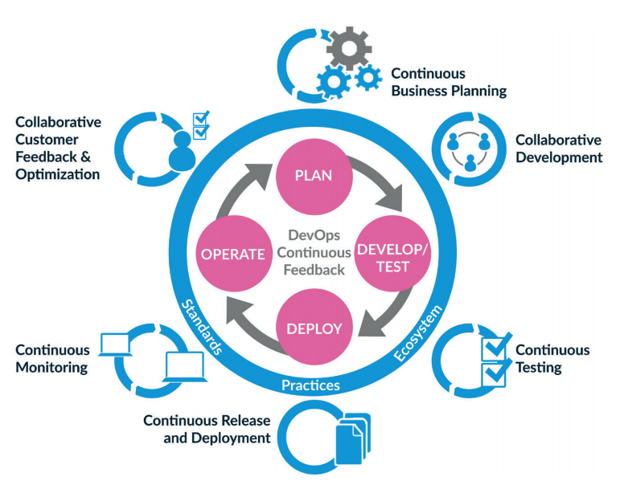
How do they co-exist?
At a glance:
- "DevOps" (Development + Operations) is an offset of the Agile revolution dedicated to increasing both time-to-market and quality-to-market.
- Enterprise Architecture (EA) ensures that DevOps teams are integrated in mutually beneficial manners to ensure that processes (especially those that are automated) are built using relevant technology and data sources.
- EA Management is a modern discipline equipped to streamline three core elements of DevOps throughout large-scale environments: Automation; Analytics; and Sharing.
It’s more fun to talk about the benefits of DevOps rather than explain why and how it gets implemented in the first place.
As enterprises become more proficient in its practices, we now take for granted the hard architectural efforts needed to merge the individual mandates of Development (“Dev”) and Operations (“Ops”) teams.
So, to set the record straight, what role does Enterprise Architecture (EA) even play in the creation of DevOps?The answer is connected, as it so often is, to the rise of “Agile” culture—a seismic shift in approaches to organizational efficiency that has affected Business and IT groups in different and somewhat conflicting ways.
Agile groups aim to maximize deliverable outputs by minimizing wasteful processes. It’s truly all about speed, whether in the re-conceptualizing of “slow” designs or the building of more communicative working environments, and it can be differentiated from the basic work philosophy of “get more with less” by its roots in digital technologies—in particular, cloud hosting.
Speed, however, means two different things to software developers and operations personnel. For those tasked with engineering 24/7 web-based services, it involves being able to frequently test and release near-invisible updates without delay. If the service is up and running, so too must the developers—a harsh reality leading to a pressurized and highly-reactive environment with little time ever actually available to evaluate actions for long-term significance.
It’s instead left to operations teams to anchor every step of agile software development processes to essential business standards. For these individuals, the pace of agile development means a greater likelihood that their company’s product offerings are going to be constructed in the wrong ways. Operations personnel are unable to slow the demands of customers so they must find nimble ways to tag all updates to security, software, and market standards without noticeably affecting delivery times.
Devs keeps Ops busy; Ops makes Devs look good. And the better the structures in place for their interactions, the more comfortable a cushion enterprises will have when pursuing the “fail forward” mantra of continuous, Agile-minded deployments—the majority of which are tethered to automated sequences.
So cue EA Management.
Image 1: An abstract of the DevOps process.
With a full-SaaS EA Management Tool, all varieties of stakeholders obtain the transparency required to take actionable decisions on the deeply-integrated patterns that run enterprise-specific DevOps processes. It’s a mechanism that’s increasingly being chosen when instituting corporate strategies into the processes of IT—and its benefits can be broken down into three core themes:
Automation
Automation, as an indispensable component of DevOps and Agile organizations wishing to scale upwards at competitive levels, is applied at all levels of modern enterprises. However, before any repeated sequence becomes wedded to the fabric of an enterprise, it must be exposed and then thoroughly scrutinized for practicality. EA Management utilizes the best practices of all architectural subsets (Information, Data, Security, etc.) to test whether reliable information and technology is being fed into autonomous development cycles.Analytics
Feedback—and the integration of it—is an essential element of DevOps that is integral to improving continuous processes. Unlike in the past when service updates occurred at (comparatively more) foreseeable intervals, the round-the-clock pressures of Agile environments means that feedback has to be given and received in remarkably efficient manners. The only solution is to hook every piece of technology to quantifiable measurements and then have this information entered, real-time, into accessible data repositories. An EA Management Tool tracks metrics related not only to the performance of technology and processes but also to the very personnel responsible for its maintenance.Sharing
Sharing ideas, problems, skills, knowledge, and winning processes is an important aspect of DevOps. It’s a kissing cousin to quality assurance and standards governance, and while the above-mentioned metrics are very much a part of this, it’s also important for modern enterprises to collect best practices from development and operations teams—whether internal or external—in order to field new Agile tactics. DevOps is about both time-to-market and quality-to-market—and an EA Management Tool’s collaborative functionality can attract the best insights on both.Like DevOps, modern EA Management was born out of a need to connect the shifting concerns of Business to the rapid behaviours of IT. As evidenced in the latest Forrester Wave Report on the top performing “EA Management Suites” of Q1 2019, more and more large-scale enterprises are aware that they can’t implement digital strategies throughout enterprises without fine-tuning automated sequences with analytics gained from expansive data-sharing platforms.
And it's one of the chief reasons why attention has increased for EA Management Tools that enable IT and Business leaders to accomplish the following:
- To pick apart, piece-by-piece, any given project and process to search for potential improvement;
- To define all running Microservices—the corresponding elements of any DevOps toolbox—and integrate overlapping terminology, requirements, and issues;
- To efficiently migrate enterprise applications and users to cloud-based environments where DevOps efforts can truly be scaled; and
- To provide all DevOps stakeholders a single source-of-truth for contextualizing strategies.
All that being said, DevOps projects can only be introduced iteratively and planned using timely evidence drawn from numerous sources. It shouldn’t be assumed that developers and operations teams will, if left untouched, naturally align themselves to the standards each expect from the other. Relationships rely on communication, and an EA Management Tool like LeanIX is a version of couples’ therapy that will get both sides talking with the right language.
![Enterprise Architecture Success Kit [White Paper]: Everything you need for quick time-to-value and long-term success through EA. »](https://no-cache.hubspot.com/cta/default/2570476/17fd5630-69af-4c4c-82f1-8e88da49fc47.png)

![The Enterprise Architect of Tomorrow [White Paper]: Practical insights on how to become data-driven, agile-minded, and forward thinking. »](https://no-cache.hubspot.com/cta/default/2570476/49fd1c31-67ad-464a-9aae-3ed5e866a24e.png)


/EN/Reports/Thumbnail-Obsolescence-Gartner.png?width=140&height=100&name=Thumbnail-Obsolescence-Gartner.png)
/EN/White-Paper/EN-IDC-Inforbrief-Application-Rationalization-Portfolio-Management-Thumbnail_v2.png?width=140&height=99&name=EN-IDC-Inforbrief-Application-Rationalization-Portfolio-Management-Thumbnail_v2.png)
